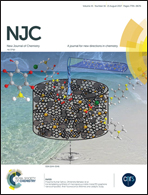Ionic liquids based on bromoxynil for reducing adverse impacts on the environment and human health†
Abstract
Many herbicides exhibit some disadvantages such as high water solubility and volatility after application, which lead to potential threats to the aquatic and atmospheric environment and human health. Herbicidal ionic liquids (HILs) can effectively eliminate these intrinsic shortcomings by pairing with appropriate counterions (cation or anion). In this study, new HILs based on bromoxynil with eight typical cations were synthesized to reduce the negative impacts of currently used forms of bromoxynil. All the obtained compounds were investigated for solubility, octanol–water partition coefficient, surface activity, volatilization rate, and herbicidal activity in a greenhouse. The results showed that the HILs with long alkyl chains in the cations had reduced water solubility and volatilization rate, better surface activity and Kow, and substantially improved efficacy against weeds over bromoxynil sodium. Due to their adjustable physicochemical properties and improved herbicidal activity, the HILs could tremendously reduce the adverse impacts of bromoxynil on the environment and human health and may be potential alternatives to currently popular forms of bromoxynil in the future.



 Please wait while we load your content...
Please wait while we load your content...